Minds On
Water

Where does water come from? Check out this video to inspire your thoughts.
Think about all the different sources of water in the entire world. What are they? Brainstorm a list of ideas orally, digitally, in print, or in another method of your choice.
Student Success
Think!
Who depends on water for survival? If possible, with a partner or group, brainstorm all those who depend on water. Categorize your ideas into the appropriate columns: Businesses/Companies, Humans, Animals/Plants, Other.
Access the following fillable and printable document Those Who Depend On Water to complete the activity. You may also answer using another method of your choice.
|
Businesses / Companies |
Humans |
Animals / Plants |
Other |
|---|---|---|---|
Press the ‘Activity’ button to access Those Who Depend On Water.
Predict what would happen if one of these groups didn’t have access to water anymore. How would they be impacted? How might they then impact other groups? Record your ideas using the method of your choice.
Note to teachers: See your teacher guide for collaboration tools, ideas and suggestions.
Safe Water
What makes water safe and healthy? Brainstorm your ideas using the method of your choice. When you are ready, press ‘Sample answer’ to learn about some possible answers to this question.
To be considered safe and healthy enough to consume, water needs to be clean, fresh (not salt water), and free of chemicals or pollutants.
Action
Global connection
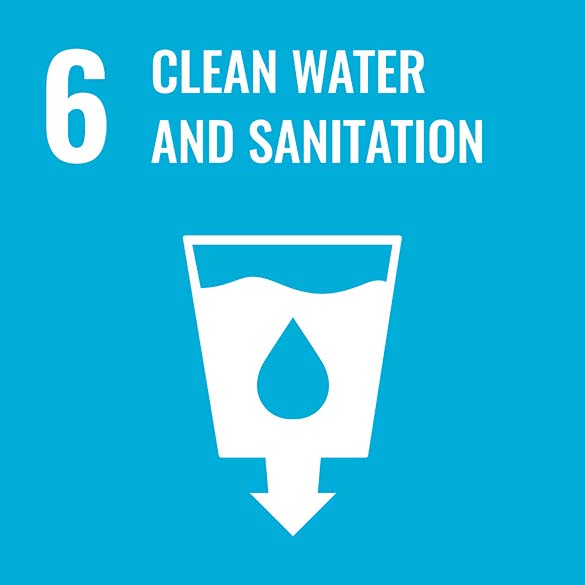
The United Nations (UN) is a group of many countries from around the world that have come together to create a better future for people and the environment. They have created 17 goals called the Sustainable Development Goals.
This learning activity is connected to Goal #6: Clean Water and Sanitation. This means everyone should have Safe drinking water and sanitation. Having clean water affects not only health but things like reducing poverty, having food security, and having a sustainable ecosystem.
Water can be found in many forms all over planet Earth. It provides habitats for many different plants and animals as well as being essential to life on Earth. Humans, animals, and plants require water to survive and thrive. Yet, worldwide, one in three people do not have access to safe drinking water and 40% of people do not have basic hand-washing facilities. In this learning activity, you will investigate and assess these issues through the lens of a scientist.
Earth’s water
Water can be found in many places on planet Earth, and in many forms. Expand each tab to explore different types of water and where each type can be found.
Let’s try to estimate how much water on Earth is in the following states: salt water, frozen fresh water, and liquid fresh water (not frozen). Use the blank circle on the document Salt Water, Frozen Fresh Water, Fresh Water Estimation to create a pie graph that estimates how much of the Earth’s water is salt water, fresh water, and frozen water.
You can use technology, or you can use the following fillable and printable document Salt Water, Frozen Fresh Water, Fresh Water Estimation to complete the activity. You may also answer using another method of your choice.
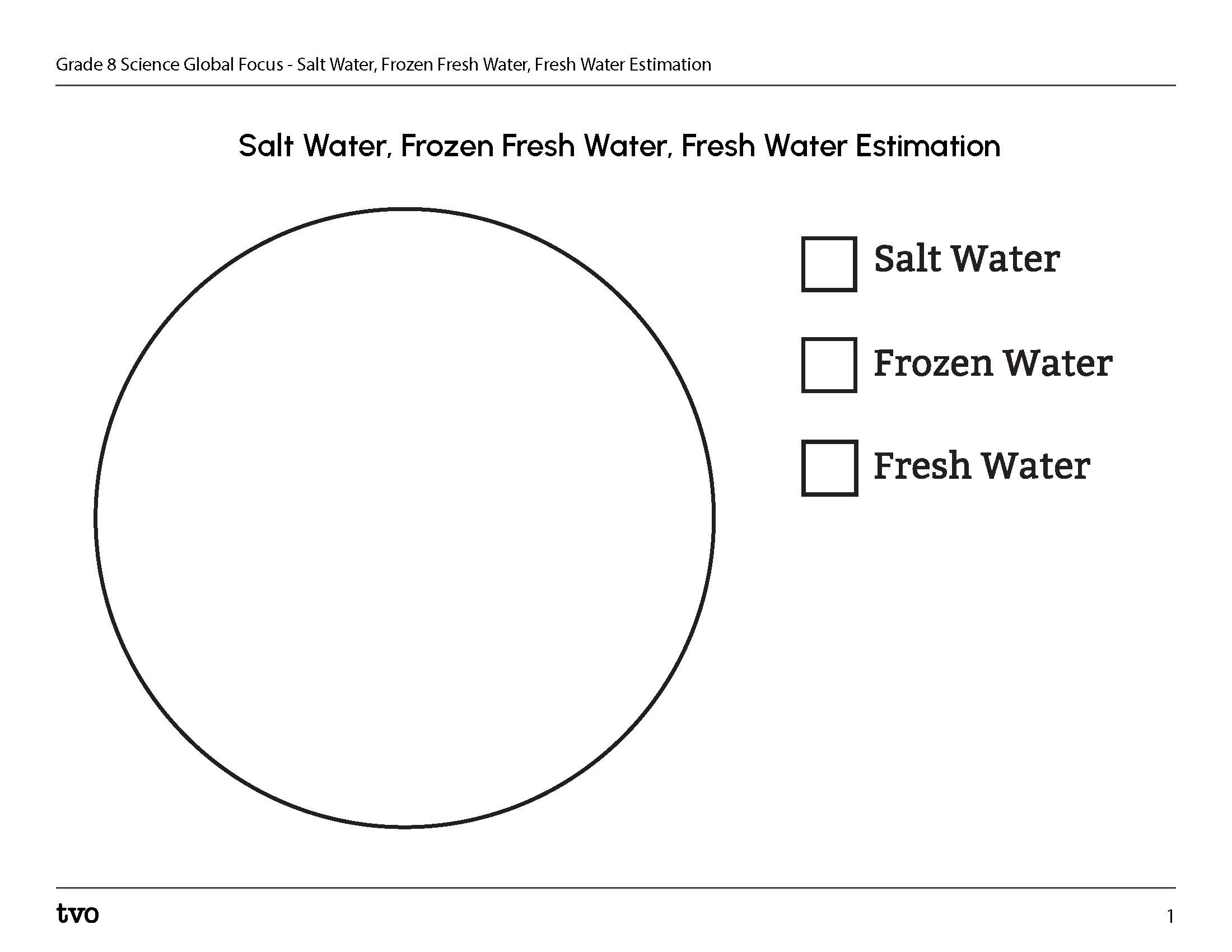
Press the Activity button to access the Salt Water, Frozen Fresh Water, Fresh Water Estimation.
Activity (Open PDF in a new tab)Now that you have completed your pie graph, it is time to compare your estimate with reality. When you are ready, press ‘Answer’ to learn the actual percentages of salt water, frozen fresh water, and liquid fresh water.
Earth’s water distribution
Most of Earth’s water—96% of it, in fact—is salt water. Of the remaining 4%, 2% is frozen fresh water, 1% is fresh water, and the final 1% is “other” water that is stored deep within the earth or is water vapour found in the air.

Frozen water
Approximately 2% of the Earth’s water is stored in glaciers and in the polar ice caps.
Press “What is a glacier?” to access an explanation of what glaciers are.
A glacier is a large accumulation of snow and ice that forms on land. Glaciers often contain rock, sediment, and liquid water.
Glaciers are constantly moving and changing shape under their own weight. This movement causes cracks, crevices, and other distinguishing features to form within the glacier. The movement of glaciers also causes changes to the land under the glaciers, moving rocks, eroding land, and causing the formation of landforms like moraines or fjords.

A mountain range with three distinct peaks. Between the first two peaks, a large pile of snow and ice labeled “glacier” fills the space between the mountains. In the foreground, the valley between the mountains is filled with water. This water-filled valley is labeled “fjord.” On the other side, a large pile of snow and ice labeled “glacier” fills the space between the second and third mountains. There is a ridge of rock and gravel in the foreground. This ridge is labeled “moraine.”
There are many aquatic species that rely on the cold water temperatures found near glaciers and the polar ice caps to survive.
Press “What are the polar ice caps?” to access an explanation of what the polar ice caps are.
The polar ice caps are areas of land at the North and South poles that are covered in ice and snow.
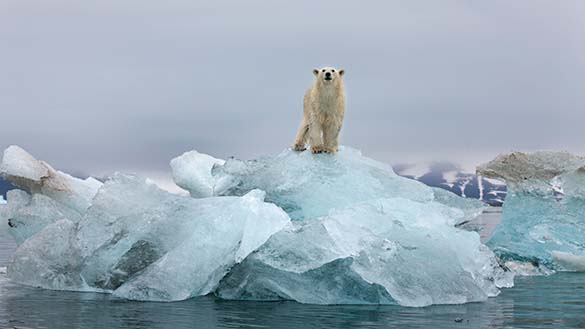
Rising temperatures caused by climate change are causing polar ice caps and glaciers to melt. As the glaciers or ice caps melt, sea levels rise, which puts coastal areas at risk of flooding. This will not only affect humans who live in coastal areas; it will also cause extinction among animals and aquatic species who rely on the glaciers, ice caps, and coastal regions as their natural habitat.
It also affects animals like polar bears. The main food source of the polar bear is the ringed seals that live in the cold waters at the edge of the ice. As the seal population shrinks due to loss of habitat, the polar bear population shrinks because less food is available.
What is causing the glaciers and ice caps to melt?
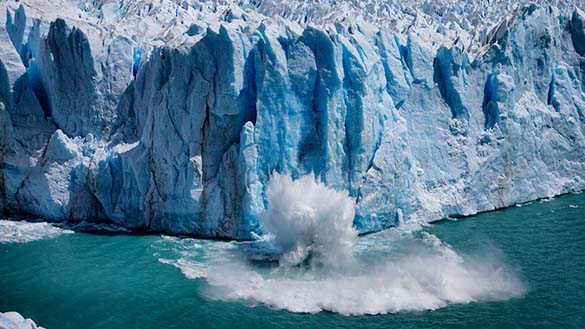
One of the biggest reasons why the glaciers and ice caps are melting is because of human activity. Carbon dioxide and other greenhouse gases are produced by factories, transportation, deforestation, and the burning of fossil fuels. This emission of carbon dioxide and other greenhouse gases contributes to climate change, which is warming the planet’s temperature at a more rapid than usual rate and causing the glaciers and polar ice caps to melt.
As the glaciers and ice caps continue to shrink, their role as a supply of water is changing. This will affect access to safe and clean drinking water for many communities. Glaciers contain freshwater. Once they melt into the ocean, that freshwater turns into undrinkable ocean water.
The state of the cleanliness of the water in the north is not completely known. One scientist group from University of Alberta found chemicals that were placed in the glaciers in the 1950s. If these melt into the water, these chemicals will affect the quality of the drinking water in the area.
Check your understanding in this sorting activity! Sort the following items into causes and effects of the melting of polar ice caps and glaciers.
- Causes: What is causing the ice to melt?
- Effects: How is the melting of the ice affecting humans and ecosystems?
The 6 targets of UN Goal 6
The United Nations Sustainable Development Goal #6 focuses on providing clean water and sanitation globally. Let’s learn more!
Targets
The United Nations’ Sustainable Development Goal 6 has 6 defined targets:
It’s time to research!
Choose one of the above targets to investigate further and complete the following graphic organizer provided. Begin your website search by exploring and gathering information from the United Nations website, non-governmental organizations, and government websites.
Resource selection checklist
I have chosen my resources by:
Use the following fillable and printable document Target of Sustainable Development Goal 6 to complete the activity. You may also answer using another method of your choice.
|
My selected target of Sustainable Development Goal 6 is: |
|
|---|---|
|
Why is this one of the targets? (Hint: Explore facts or information about areas in the world that currently don’t have access to water) |
|
|
What is being done to reach this target? (Hint: What are organizations doing to help in other countries or locally to achieve this goal) |
|
Press the ‘Activity’ button to access Target of Sustainable Development Goal 6.
Indigenous perspectives on water
Water has a strong tie to the physical and spiritual well-being of humans. Let’s learn about some indigenous perspectives on water.
It is important to note that Indigenous worldviews regarding water are not all the same; however, some traditional beliefs and values towards water are shared across First Nations, Métis, and Inuit communities.
Water is viewed as a living-being that should be respected to maintain a way of life and health. Water is part of a greater interconnected whole and we must consider everything that water is connected to, not just its use for humans. Water is about relationships. Next, explore this video entitled Relationship with Land and Water to learn about the Kitchenuhmaykoosib Inninuwug First Nation’s perspective on water.
Another perspective is that of the Māori people of Aotearoa, New Zealand. They trace their genealogy to a specific river, which is their relative. They have a strong sense of responsibility over the protection and maintenance of water to ensure the health and wellbeing of the entire ecosystem, not just humans.
It is important to understand and include traditional Indigenous knowledge when managing water. This traditional knowledge can be used to help restore ecosystems and offer frameworks for building more sustainable, holistic, and equitable approaches to water management and access. Over the years, Indigenous communities throughout the world have advocated for this traditional knowledge to be shared and implemented when addressing global water issues.
Pause and Reflect
Pause and reflect
- What are some of the ways you use and experience water? For example, having a drink of water or going for a swim in a lake.
- How would you describe your feelings and beliefs about water?
Record your ideas in a notebook or using another method of your choice.
The right to water

“Indigenous peoples have the right to maintain and strengthen their distinctive spiritual relationship with their traditionally owned or otherwise occupied and used lands, territories, waters, and coastal seas and other resources, and to uphold their responsibilities to future generations in this regard.”
— Article 25 of the United Nations Declaration on the Rights of Indigenous Peoples (UNDRIP)
Water is necessary for all human and animal life on Earth. Indigenous peoples have long understood the importance of water and that it is each and every person’s responsibility to protect the waters for future generations. However, Indigenous peoples around the world are not afforded the same human rights as Canadians, including their right to protect and access water.
Access to drinking water is a human right. In 2003, the United Nations Committee on Economic, Social and Cultural Rights adopted General Comment No. 15, which affirmed that the human right to water entitles everyone to sufficient, safe, acceptable, physically accessible, and affordable water for personal and domestic uses.
The adoption of UNDRIP
In 2007, the United Nations General Assembly adopted the United Declaration of the Rights of Indigenous Peoples. It is designed to identify a standard for the treatment of Indigenous peoples and to assist them in combatting discrimination and marginalization.

The United Nations Declaration on the Rights of Indigenous Peoples (UNDRIP) provides a comprehensive overview of the responsibilities all countries have to the Indigenous peoples of that territory. It includes a number of specific articles related to those responsibilities, including responsibilities related to culture, identity, language, health, well-being, education, and other important issues, as well as their collective and individual rights.
UNDRIP is not legally binding under international law. It is a set of rights designed to help countries ensure their Indigenous peoples have a more just and equitable future. Canada originally voted against adopting this declaration, but eventually became a full supporter of this declaration in 2016, nearly 10 years after it was first introduced.
Taking the initiative
Despite the Government of Canada’s adoption of UNDRIP, there are many Indigenous communities in Canada that do not have access to safe, clean drinking water. Indigenous peoples have been advocating for change to ensure their communities have their basic human rights fulfilled. They have also started initiatives and partnerships to help continue their tradition of protecting the water for future generations.
The following five Indigenous initiatives are working toward Indigenous peoples’ right to protect and access clean drinking water. Choose one of the following initiatives to learn more about, or choose another water initiative of your choice:
Pause and Reflect
Pause and reflect
- How does the initiative you chose to learn more about contribute to science and technology?
- What, if any, knowledges and values about water, connections to water, and ways of managing water resources sustainably are evident in this initiative?
- Is there evidence of any emerging technologies (such as coding or artificial intelligence) in this initiative? If yes, what emerging technologies are present? If not, can you think of an emerging technology that would support this initiative?
Record your ideas in a notebook or using another method of your choice.
Career exploration
Part of solving the issues related to lack of drinking water is to have trained professionals that can help keep the water safe and clean for communities.

An environmental engineer identifies and analyzes existing contamination of water sources to produce high-quality drinking water for people. They identify the concentration of any harmful contaminants in the water, as well as sources and impacts. They also design drinking water treatment facilities that bring safe drinking water to our homes.
A water technician treats domestic and drinking water to provide safe drinking water to a community. To do this, they must understand the working and operations of every piece of equipment in a water treatment plan.
Connections
Career profile: June Williams
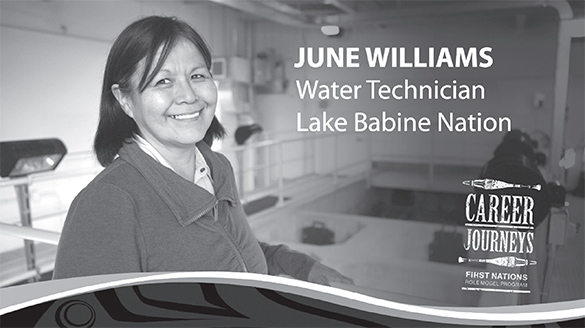
June Williams is the Chief Operator at the Tachet Water Treatment Plant in Tachet, Babine Lake. She finds her job very rewarding because she gets to provide clean and safe drinking water to her local community. Explore the following list to learn more about June!
- Education: Grade 12 graduation, Water Treatment Technology Diploma, and certification training courses in water treatment
- Motivation and Support: June’s parents instilled how important learning was and were very supportive during her schooling and training
- Quote: “Find something that will interest you and develop it further. If you find something that you like and enjoy, it won’t seem like work. Desire, commitment, perseverance.”
Would you consider a career in water?
Would you consider a career helping preserve water habitats and keep water safe and clean for communities? Choose one of the following careers to explore further:
Answer the following questions using a method of your choice:
- What education is required for a career like this?
- How does this career contribute to UN Goal 6 of providing clean drinking water and sanitation worldwide?
- Would you consider this career? Why or why not?
Consolidation
Sharing my knowledge
Explore this video of Autumn Peltier speaking at the United Nations about water.
Student Success
Think!

Choose one of the following options to share your knowledge about water. If possible, work with a partner or group.
- In a short blog post (digital, in print, or in an audio recording), share what water means to you and what you have learned about water on Earth. Be sure to include how Indigenous perspectives and careers are contributing to meeting UN Goal 6 of providing clean drinking water and sanitation worldwide.
- Create a speech about what water means to you and what you have learned about water on Earth. Be sure to include how Indigenous perspectives and careers are contributing to meeting UN Goal 6 and providing clean drinking water and sanitation worldwide.
Use the following checklist to guide your thinking.
Note to teachers: See your teacher guide for collaboration tools, ideas and suggestions.
Reflection
As you read the following descriptions, select the one that best describes your current understanding of the learning in this activity. Press the corresponding button once you have made your choice.
I feel…
Now, expand on your ideas by recording your thoughts using a voice recorder, speech-to-text, or writing tool.
When you review your notes on this learning activity later, reflect on whether you would select a different description based on your further review of the material in this learning activity.